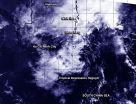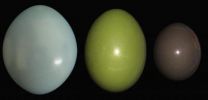(Press-News.org) VIDEO:
A wide-field movie by GOES-WEST of the North Pacific from Dec. 9-12, 2014 reveals the violent rain storms pouring moisture on the "Pineapple Express " jet stream into California in mid-December....
Click here for more information.
The ''Pineapple Express'' happens when warm air and lots of moisture are transported from the Central Pacific, near Hawaii, to the Eastern Pacific Ocean. An animation of satellite imagery from NOAA's GOES-West satellite showed the stream of clouds associated with that moisture from Dec. 9 to Dec. 12, 2014 and brought rain and snow to the western U.S.
A wide-field movie by NOAA's GOES-West satellite shows the Pineapple Express' stream of clouds and moisture that created violent rain storms in California, record rainfall, landslides and flash flooding in the San Francisco area. The video was created by NASA/NOAA's GOES Project at NASA's Goddard Space Flight Center in Greenbelt, Maryland.
On Dec. 11, the storm system generated winds gusts that damaged homes in Lake Tahoe area, and rain and snow in Northern California. Whiteouts were reported the Sierra Nevada Mountains. Oregon and Washington State also experienced rain and snow.
Bill Patzert, climatologist for NASA's Jet Propulsion Laboratory in Pasadena, California said, "After three years of punishing drought, Californians are shaken by this second December 'Pineapple Express' enhanced soaker. The storm did some damage, but it is also moving through California quickly and will probably not be a record-breaker."
Patzert compared this 'Express' to the storms of December 2010, when 10.23 inches of rain fell in Los Angeles from Dec. 6 to 29, causing massive flooding. "Those storms just kept coming. It was memorable," he said. "This storm was like a 12-hour event. That was a 12-day event."
The International Space Station-RapidScat instrument captured wind data near central California's coast on Dec. 12 at 01:43 UTC (5:43 p.m. PST, Dec. 11). The RapidScat image showed sustained winds of 30 meters per second/67 mph just off-shore from the San Francisco area.
On Dec. 12 at 3:48 a.m. EST, NOAA's National Weather Service Weather Prediction Center (NPC) in College Park, Maryland issued a short range forecast discussion about the Pineapple Express.
NPC noted: A strong Pacific storm will continue moving through the western states through the weekend. Impacts will include heavy precipitation, including mountain snows affecting travelers, strong, damaging winds, flash flooding, mud and debris flows, mainstem river flooding and damaging high surf. Thunderstorms and waterspouts are possible Friday in California and just off the coast.
From Los Angeles to San Diego and points south on Dec. 12, an Urban and Small Stream Flood Advisory is in effect. In addition a high surf advisory in effect for southwest California beaches through Saturday.
Patzert said the greatest upside of the recent storms were for the northern and central Sierras, where places like Southern California get much of their water. "They¹re definitely getting snow," he said. "The snow season is getting off to a fast start and that's a huge plus regarding drought relief."
GOES satellites provide the kind of continuous monitoring necessary for intensive data analysis. Geostationary describes an orbit in which a satellite is always in the same position with respect to the rotating Earth. This allows GOES to hover continuously over one position on Earth's surface, appearing stationary. As a result, GOES provide a constant vigil for the atmospheric "triggers" for severe weather conditions such as tornadoes, flash floods, hail storms and hurricanes.
INFORMATION:
For updated information about the storm system, visit NOAA's National Weather Service website: http://www.weather.gov
For more information about GOES satellites, visit: http://www.goes.noaa.gov/ or http://goes.gsfc.nasa.gov/
Tropical Cyclone Bakung is moving in a westerly direction over the open waters of the Southern Indian Ocean and NASA's Aqua satellite captured an image of the sea storm.
Aqua passed over Bakung on Dec. 12 at 07:35 UTC (2:35 a.m. EST) and the MODIS instrument aboard took a visible image of the storm. The image showed that deeper convection (stronger currents of rising air that form the thunderstorms that make up the tropical cyclone) was occurring around the low-level center of circulation, so the center was not apparent in the MODIS imagery. The bulk of the clouds associated ...
Splashy blue and green hues pop from under the glassy finish of the Tinamou species' (bird relatives of ostriches, rheas and emus) eggs. Pigments covered by a thin, smooth cuticle reveal the mystery behind these curious shells, University of Akron researchers discovered. The finding could lead to the development of glossy new coatings for
ceramics and floors, potentially enhancing their aesthetic qualities and durability.
After removing the outer layer of the eggshells and examining their chemistry and nanostructure, the researchers discovered the presence of a weak ...
Extreme climate and weather events such as record high temperatures, intense downpours and severe storm surges are becoming more common in many parts of the world. But because high-quality weather records go back only about 100 years, most scientists have been reluctant to say if global warming affected particular extreme events.
On Wednesday, Dec. 17, at the American Geophysical Union's Fall Meeting in San Francisco, Noah Diffenbaugh, an associate professor of environmental Earth system science at the Stanford School of Earth Sciences, will discuss approaches to this ...
PHILADELPHIA -- Frequent kidney dialysis is essential for the approximately 350,000 end-stage renal disease (ESRD) patients in the United States. But it can also cause systemic inflammation, leading to complications such as cardiovascular disease and anemia, and patients who rely on the therapy have a five-year survival rate of only 35 percent. Such inflammation can be triggered when the complement cascade, part of the body's innate immune system, is inadvertently activated by modern polymer-based dialysis blood filters. New work by Penn researchers has found an effective ...
Like a smart sensor that adjusts the lighting in each room and a home's overall temperature, a protein that governs the making of other proteins in the cell also appears capable of controlling fat levels in the body.
The finding, which appeared in Cell Reports on Dec. 11, applies to the Maf1 protein in worms.
A version of the protein, which exists in humans, also regulates protein production in the cell, raising the possibility that it too may control fat storage. A protein with such a function would offer a new target for pharmaceuticals to regulate fat, said Sean ...
The Perioperative Surgical Home (PSH) model consistently and significantly improves quality of care for patients and reduces health care costs, reports a first-of-its-kind, large-scale literature review of the PSH in the United States and abroad. The review, published online this month in Milbank Quarterly, provides further evidence to support the benefits, and encourage the adoption, of the PSH model.
"There is a global push for more rigorously coordinated and integrated management of surgical patients to enhance patient satisfaction and improve quality of care and ...
Oil reservoirs are scattered deep inside the Earth like far-flung islands in the ocean, so their inhabitants might be expected to be very different, but a new study led by Dartmouth College and University of Oslo researchers shows these underground microbes are social creatures that have exchanged genes for eons.
The study, which was led by researchers at Dartmouth College and the University of Oslo, appears in the ISME Journal. A PDF is available on request.
The findings shed new light on the "deep biosphere," or the vast subterranean realm whose single-celled residents ...
BOZEMAN, Mont. - Cathy Cripps doesn't seem to worry about the grizzly bears and black bears that watch her work, but she is concerned about the ghosts and skeletons she encounters.
The ghosts are whitebark pine forests that have been devastated by mountain pine beetles and white pine blister rust, said the Montana State University scientist who studies fungi that grow in extreme environments. The skeletons are dead trees that no longer shade snow or produce pine cones. The round purple pine cones hold the seeds that feed bears, red squirrels and Clark's nutcracker birds. ...
Amsterdam, NL, December 12, 2014 - A patient who had suffered a traumatic brain injury unexpectedly recovered full consciousness after the administration of midazolam, a mild depressant drug of the GABA A agonists family. This resulted in the first recorded case of an "awakening" from a minimally-conscious state (MCS) using this therapy. Although similar awakenings have been reported using other drugs, this dramatic result was unanticipated. It is reported in Restorative Neurology and Neuroscience.
Traumatic brain injuries occur at high rates all over the world, estimated ...
New Rochelle, NY, December 11, 2014--In cases of traumatic brain injury (TBI), predicting the likelihood of a cranial lesion and determining the need for head computed tomography (CT) can be aided by measuring markers of bone injury in the blood. The results of a new study comparing the usefulness of two biomarkers released into the blood following a TBI are presented in Journal of Neurotrauma, a peer-reviewed journal from Mary Ann Liebert, Inc., publishers. The article is available free on the Journal of Neurotrauma website at http://online.liebertpub.com/doi/full/10.1089/neu.2013.3245 ...





